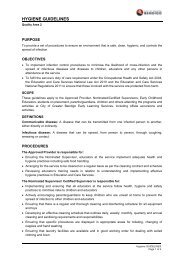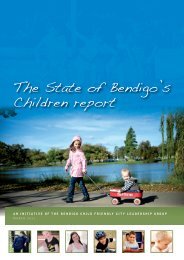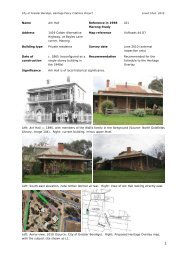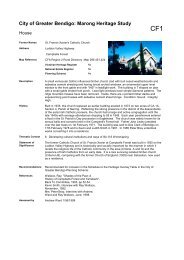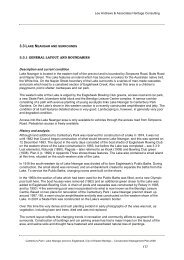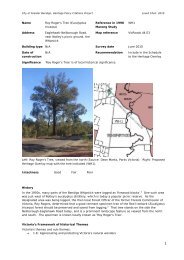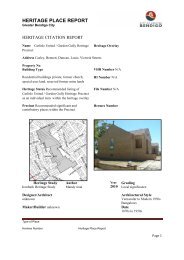Vol 2 Heritage Policy Citation Review - City of Greater Bendigo
Vol 2 Heritage Policy Citation Review - City of Greater Bendigo
Vol 2 Heritage Policy Citation Review - City of Greater Bendigo
You also want an ePaper? Increase the reach of your titles
YUMPU automatically turns print PDFs into web optimized ePapers that Google loves.
<strong>City</strong> <strong>of</strong> <strong>Greater</strong> <strong>Bendigo</strong>, <strong>Heritage</strong> <strong>Policy</strong> <strong>Citation</strong>s Project Lovell Chen, 2010<br />
The Uniting Church (former Wesleyan) complex at Kangaroo Flat comprises a substantial gabled<br />
bichrome brick Gothic Revival church (1871) and a brick Sunday School (1936). The buildings are<br />
located on elevated ground behind a small open landscaped park close to Kangaroo Flat’s historic<br />
centre. The 1871 church, designed by Melbourne architects Crouch and Wilson, superseded an earlier<br />
(1858) church within the same allotment. The 1858 church then became a Sunday School, prior to its<br />
demolition in 1936 and replacement with the present Sunday School. Despite the unsympathetic<br />
modifications and additions to the east, the 1871 church remains a substantial and prominent<br />
structure with a strong Gothic Revival character. The gabled west façade <strong>of</strong> the 1871 church, facing<br />
High Street, is subdivided into three elements, having a central geometric arched west window and<br />
doors in each flanking bay, with three oculus windows outlined in cream brick. The main window has<br />
four lancets rising to support three quatrefoils with seven linking triangular lights. The side windows<br />
are all simple lancets with diamond-pattern lead pane joints, and heads expressed in cream brick.<br />
The plinth is <strong>of</strong> rough-cut sandstone and there is a decorated wrought iron cross at the gable apex.<br />
The steeply pitched ro<strong>of</strong> has slate tile cladding. The lower gable edges are finished with two kneelers<br />
delineated in cream brick. The facade also has a pair <strong>of</strong> diagonal two-stage buttresses in red brick<br />
with cream brick <strong>of</strong>f-sets, a treatment repeated on the six other buttresses to the side walls. The plan<br />
is a basic nave, and there is no chancel expressed externally.<br />
How is it significant?<br />
The Uniting Church is <strong>of</strong> local historical, social and aesthetic/architectural significance.<br />
Why is it significant?<br />
The 1871 Uniting Church (former Wesleyan Church) is historically significant (Criterion A) as the<br />
centre <strong>of</strong> Methodism at Kangaroo Flat since 1858, with the present church the focus <strong>of</strong> Methodism<br />
since 1871, initially as the Wesleyan Church and since 1977 as the Uniting Church. The Methodist<br />
sects were well represented in the former Marong Shire from the earliest years <strong>of</strong> European<br />
settlement, reflecting the presence <strong>of</strong> Cornish miners in the district. The presence <strong>of</strong> the Methodists,<br />
and this substantial 1871 church, also provides evidence <strong>of</strong> the diversity <strong>of</strong> religious communities on<br />
the broader goldfields. The 1936 Sunday School additionally is <strong>of</strong> significance, and provides evidence<br />
<strong>of</strong> the ongoing role and presence <strong>of</strong> the church in the local community into the first half <strong>of</strong> the<br />
twentieth century. Socially (Criterion G), the Uniting Church is significant as the focus <strong>of</strong> the<br />
Methodist community, initially the Wesleyan Church and later the Uniting Church, since 1871.<br />
The Uniting Church is also <strong>of</strong> aesthetic/architectural significance (Criterion E). The building, although<br />
unsympathetically modified and extended, remains a substantial and prominent gabled bichrome brick<br />
Gothic Revival church. It is an example <strong>of</strong> the work <strong>of</strong> Crouch and Wilson, noted Melbourne<br />
architectural practice, which demonstrates the tri-partite façade treatment which was a characteristic<br />
<strong>of</strong> the firm's churches. Elements <strong>of</strong> note include the central geometric arched west window with four<br />
lancets rising to support three quatrefoils with linking triangular lights; three main gable oculus<br />
windows outlined in cream brick; side windows with simple lancets and diamond-pattern leadlights;<br />
picturesque steeply pitched ro<strong>of</strong>; wall buttressing; and brick quoining. The church also has landmark<br />
qualities by virtue <strong>of</strong> its scale and presentation, as well as its location on a generous, informally<br />
landscaped and elevated site at the south <strong>of</strong> Kangaroo Flat’s historic core. The 1936 Sunday School is<br />
also <strong>of</strong> note. While appropriately subservient to the church in scale and footprint, the smaller building<br />
has elements <strong>of</strong> interest including the distinctive cruciform pitched truss ro<strong>of</strong> with two transverse<br />
wings to each side <strong>of</strong> the main gable; use <strong>of</strong> red brick with a rough cast gable end, and decorated<br />
panels in clinker brick; a central gable vent and a broad bracketed gable eave; and the Gothic<br />
influenced four-light timber-framed central fanlight window, flanked by a pair <strong>of</strong> two-stage buttresses.<br />
Recommendations<br />
The property is recommended for inclusion in the Schedule to the <strong>Heritage</strong> Overlay <strong>of</strong> the <strong>City</strong> <strong>of</strong><br />
<strong>Greater</strong> <strong>Bendigo</strong> Planning Scheme. Although the extent <strong>of</strong> the Overlay is shown in the above map,<br />
reflecting the property boundary, the focus <strong>of</strong> significance is on the 1871 and 1936 buildings. The<br />
face brick walling should remain unpainted. The additions are not significant, and if removed in the<br />
future could provide the opportunity to reinstate the original church building form. It is recommended<br />
that the property be inspected for structural movement.<br />
5




